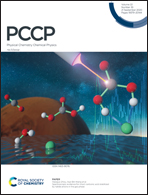Enhanced optical anisotropy via dimensional control in alkali-metal chalcogenides†
Abstract
Crystals with both large birefringence and wide transparent range are suitable for broad applications in the areas of optical communications, the laser industry and modulation of the light polarization requirement. In this work, to assist the design of urgently needed crystals with large birefringence in the infrared (IR) region, typical alkali-metal chalcogenides, KPSe6, Na2Ge2Se5, and Li2In2GeSe6 have been studied. They exhibit a hierarchical characteristic in the calculated birefringence by about 0.21, 0.11, and 0.04, respectively. To explore the origin of the birefringence difference, the polarizability anisotropy and the effect of electron distribution anisotropy are analyzed. The alkali-metal chalcogenides KPSe6, Na2Ge2Se5, and Li2In2GeSe6 feature infinite one-dimensional (1D) chains of [PSe6], 2D anionic framework of [Ge2Se5] layers and 3D [In2GeSe9] networks, respectively. It is found that the anionic group with low-dimensional configuration could enhance polarizability anisotropy and render large birefringence for the macroscopic structure. This provides evidence that a low-dimensionality configuration in the structure would be beneficial for the enhancement of optical anisotropy, which can motivate the exploration and design of novel IR birefringent materials.



 Please wait while we load your content...
Please wait while we load your content...